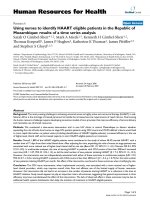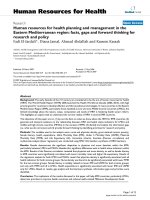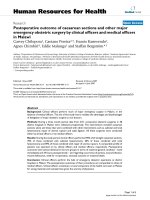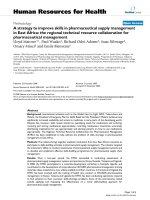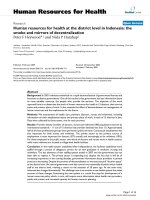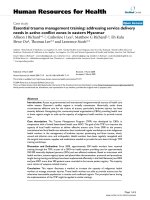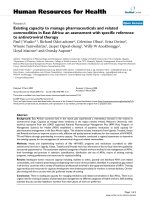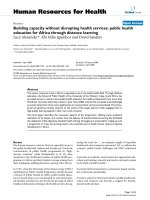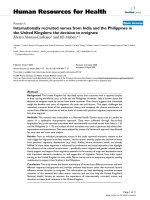báo cáo sinh học:" Existing capacity to manage pharmaceuticals and related commodities in East Africa: an assessment with specific reference to antiretroviral therapy" ppt
Bạn đang xem bản rút gọn của tài liệu. Xem và tải ngay bản đầy đủ của tài liệu tại đây (180.9 KB, 5 trang )
BioMed Central
Page 1 of 5
(page number not for citation purposes)
Human Resources for Health
Open Access
Research
Existing capacity to manage pharmaceuticals and related
commodities in East Africa: an assessment with specific reference
to antiretroviral therapy
Paul J Waako*
1
, Richard Odoi-adome
2
, Celestino Obua
1
, Erisa Owino
2
,
Winnie Tumwikirize
1
, Jasper Ogwal-okeng
1
, Willy W Anokbonggo
1
,
Lloyd Matowe
3
and Onesky Aupont
4
Address:
1
Department of Pharmacology and Therapeutics, Makerere University, College of Health Sciences, Box 7072, Kampala, Uganda,
2
Department of Pharmacy, Makerere University, College of Health Sciences, Box 7072, Kampala, Uganda,
3
Management Sciences for Health,
Rational Pharmaceutical Management Project, Washington DC, USA and
4
Department of Ambulatory Care and Prevention, Drug Policy Research
Group, Harvard Medical School, Boston, Massachusetts, USA
Email: Paul J Waako* - ; Richard Odoi-adome - ; Celestino Obua - ;
Erisa Owino - ; Winnie Tumwikirize - ; Jasper Ogwal-okeng - ;
Willy W Anokbonggo - ; Lloyd Matowe - ; Onesky Aupont -
* Corresponding author
Abstract
Background: East African countries have in the recent past experienced a tremendous increase in the volume of
antiretroviral drugs. Capacity to manage these medicines in the region remains limited. Makerere University, with
technical assistance from the USAID supported Rational Pharmaceutical Management Plus (RPM Plus) Program of
Management Sciences for Health (MSH) established a network of academic institutions to build capacity for
pharmaceutical management in the East African region. The initiative includes institutions from Uganda, Tanzania, Kenya
and Rwanda and aims to improve access to safe, effective and quality-assured medicines for the treatment of HIV/AIDS,
TB and Malaria through spearheading in-country capacity. The initiative conducted a regional assessment to determine
the existing capacity for the management of antiretroviral drugs and related commodities.
Methods: Heads and implementing workers of fifty HIV/AIDS programs and institutions accredited to offer
antiretroviral services in Uganda, Kenya, Tanzania and Rwanda were key informants in face-to-face interviews guided by
structured questionnaires. The assessment explored categories of health workers involved in the management of ARVs,
their knowledge and practices in selection, quantification, distribution and use of ARVs, nature of existing training
programs, training preferences and resources for capacity building.
Results: Inadequate human resource capacity including, inability to select, quantify and distribute ARVs and related
commodities, and irrational prescribing and dispensing were some of the problems identified. A competence gap existed
in all the four countries with a variety of healthcare professionals involved in the supply and distribution of ARVs. Training
opportunities and resources for capacity development were limited particularly for workers in remote facilities. On-the-
job training and short courses were the preferred modes of training.
Conclusion: There is inadequate capacity for managing medicines and related commodities in East Africa. There is an
urgent need for training in aspects of pharmaceutical management to different categories of health workers. Skills building
activities that do not take healthcare workers from their places of work are preferred.
Published: 9 March 2009
Human Resources for Health 2009, 7:21 doi:10.1186/1478-4491-7-21
Received: 1 February 2008
Accepted: 9 March 2009
This article is available from: />© 2009 Waako et al; licensee BioMed Central Ltd.
This is an Open Access article distributed under the terms of the Creative Commons Attribution License ( />),
which permits unrestricted use, distribution, and reproduction in any medium, provided the original work is properly cited.
Human Resources for Health 2009, 7:21 />Page 2 of 5
(page number not for citation purposes)
Introduction
Over the past few years, East African countries have expe-
rienced a tremendous increase in the volume of antiretro-
viral drugs. This is a direct result of the commendable
global initiatives towards improving access to effective
treatment of HIV/AIDS [1,2]. Lack of adequate human
resources to support scale-up of treatment programs has
been a major constraint to treatment programs. In partic-
ular, pharmaceutical supply management systems are
notably weak [3], yet they are crucial for successful scale-
up of treatment programs [4,5].
To build in-country and regional capacity in pharmaceu-
tical management, Uganda's Makerere University, with
technical assistance from the USAID supported Rational
Pharmaceutical Management Plus (RPM Plus) Program of
Management Sciences for Health (MSH) established the
Regional Technical Resource Collaboration (RTRC), a net-
work of academic institutions to build capacity for phar-
maceutical management. The initiative [6], which
includes institutions from Uganda, Tanzania, Kenya and
Rwanda aims to improve access to safe, effective and qual-
ity-assured medicines for the treatment of HIV/AIDS, TB
and Malaria through spearheading in-country capacity
building and operational research activities. To identify
specific human resources constraints for pharmaceutical
supply management, an assessment was carried out in
each of the four countries. The specific objective of the
assessment was to determine the existing capacity of the
health care system to select, quantify, distribute, and use
ARVs; determine the categories of health workers involved
in the supply management of ARVs and assess their
knowledge and practice with regard to management and
use of ARVs; document the nature of current training pro-
grams for ART commodities supply management, identify
knowledge gaps and suggest necessary intervention to
redress the constraints.
Methods
A cross-sectional survey of fifty governmental and non-
governmental institutions accredited to provide ART serv-
ices in the four countries was conducted in the months of
February and March 2005. One researcher from Makerere
University and one in-country collaborator carried out the
assessment. The assessment used a qualitative research
methodology that included interviewing key informants,
in-depth interviews of health care workers, and a survey of
health facilities and programs.
Setting and sampling
The survey covered both urban and rural areas and looked
at different facets of healthcare provision including, pub-
lic, private-for-profit, and private not-for-profit sectors. By
convenience sampling, a minimum of 10 facilities were
targeted in each country and at least three healthcare
workers from each facility were interviewed.
The assessment process
The assessment was standardized across the participating
countries through a planning workshop, which brought
together collaborators from Makerere University, Harvard
Centre for International health, Management Sciences for
Health, and two representatives of the AIDS Control Pro-
gram from each of the four countries. The workshop
reviewed the data collection tools, discussed the assess-
ment logistics and process and agreed on time lines. Data
collection tools were piloted at three health facilities and
two programs in Uganda and their validity and reliability
ascertained. These were later excluded from the main
study. Permission to carry out the survey was obtained
from the national HIV/AIDS control programs of the
respective countries. Appointments with heads of the
facilities and respondents were made by personnel from
the national AIDS control program in each country.
Interview of key informants
The heads of the National AIDS Control Programs, Minis-
try of Health Pharmacy Services, and HIV treatment pro-
grams were identified as key informants. Using the data
collection tool information on; the general features of the
country's ARV supply system [accessibility, availability,
funding, monitoring and supervision], qualification and
training of health care workers involved in supply man-
agement of ARVs and related commodities, and the train-
ing needs for the supply management of pharmaceuticals
was sought in a face to face interview.
Survey of health facilities and programs
The heads of the facilities providing ART services in the
four countries were the key informants at the program
level. The survey looked at the types of HIV/AIDS services
provided, the existence of guidelines for management of
ARVs and related commodities, the qualification of
healthcare workers managing the supply of pharmaceuti-
cals, existence of any ongoing skills building activities,
and areas covered in ongoing training programs.
In-depth interviews of health care workers
Structured in-depth interviews of healthcare providers
were held with physicians, pharmacists, pharmacy assist-
ants, nurses and clinical officers. Information was sought
on training background, knowledge of ARV supply man-
agement systems and the quality of the service provided.
Data analysis
At the end of each survey, questionnaires were checked for
completeness, accuracy and consistency. At the end of
each assessment, analysis of the data involved discussion
with various in-country stakeholders for more in-depth
Human Resources for Health 2009, 7:21 />Page 3 of 5
(page number not for citation purposes)
interpretation of perceptions and opinion on possible
interventions to address identified problems. Quantita-
tive data were analyzed using EPI INFO Version 3.3, while
qualitative data were coded and manually analyzed. No
statistical comparisons were made as this was a situational
analysis survey without sufficient power for such analysis.
Results
ART treatment programs in the four countries
National AIDS Control Programs were responsible for the
development and implementation of HIV/AIDS treat-
ment policies in all four countries. Public, private-not-for
profit and private-for-profit institutions were involved in
HIV/AIDS treatment and care in all the four countries. In
the public institutions HIV/AIDS treatment was limited to
district level facilities or higher at the time of the assess-
ment.
A total of 54 facilities involved in ART services were sur-
veyed in the four countries, comprising of 27 public, 18
private not-for-profit, 5 private-for-profit, and 4 academic
institutions (Table 1). The majority of facilities were
located in urban or peri-urban areas. A total of 110 health
workers were interviewed, the majority of whom were
pharmacists (32) followed by nurses/midwives (27), doc-
tors (20), pharmacy technicians (20), social workers (9),
clinical officer (1) other (1) (Table 2). Generally health-
care workers involved in the pharmaceutical management
of ARVs included pharmacists, nurses/midwifes, phar-
macy technicians, pharmacy assistants, social workers and
administrative staff. In some countries not all categories
of health workers were involved in the supply manage-
ment of ARVs. In Uganda the supply management of HIV/
AIDS pharmaceuticals is mainly by lower to mid-level
health workers (Figure 1)
Guidelines for the supply management of HIV/AIDS
existed in all the countries but were not always available
at treatment centers. Such guidelines however varied from
country to country.
HIV/AIDS Pharmaceutical Management Training
Training on HIV/AIDS mainly focused on the clinical
management. Very few programs included pharmaceuti-
cal supply management in their training programs.
Respondents indicated that there was critical need for
training on HIV/AIDS pharmaceutical supply manage-
ment. Specific areas on HIV/AIDS pharmaceutical supply
management where training was needed included the
selection of medicines, procurement procedures, quantifi-
cation of needs, distribution, inventory control/storage
and rational prescribing and dispensing. Table 3 shows
the areas in HIV/AIDS pharmaceutical management
where skills building was required, the perceived cause of
the problem and possible interventions. On the preferred
modes of delivering training, on-the-job training and
short workshops were the preferred by respondents.
Discussion and recommendations
Numerous problems were identified in the four countries
with regard to HIV/AIDS pharmaceutical supply manage-
ment, as was earlier reviewed in sub-Saharan Africa [7]. In
this study the major problems pertained to various facets
of human resource constraints including inadequate
number of personnel being involved in the supply chain,
staff being inadequately trained and staff being inade-
quately remunerated. Lessons from other countries like
Thailand and Brazil would come in handy to improve
management of ARVs [8]. However local and appropriate
Table 1: Category of institutions surveyed in the four countries
Category of Institution Kenya Rwanda Tanzania Uganda Total
Public Institutions 6 7 8 6 27
Private not-for-profits 5 3 3 7 18
Private for profit 2 1 - 2 5
Academic institutions - 1 1 2 4
Total 13 12 12 17 54
Distribution of healthcare workers managing HIV/AIDS phar-maceuticals in UgandaFigure 1
Distribution of healthcare workers managing HIV/
AIDS pharmaceuticals in Uganda.
Pharmacy
technicians
15%
Counselors
10%
Nursing/pharmacy
assistants
19%
Others
4%
Pharmacists
1%
Nurses/midw ives
51%
Human Resources for Health 2009, 7:21 />Page 4 of 5
(page number not for citation purposes)
interventions are necessary to address the human resource
constraints in the supply chain of pharmaceuticals.
The study further showed that few workers had received
training on HIV/AIDS pharmaceutical management. The
assessment showed a need for training in ARV supply
management, and use in the four countries. In addition to
training, there is need to develop clear and concise guide-
lines on the supply management and use of ARVs. Train-
ing methods that draw health workers away from their
work places for long periods of time are unpopular. On-
the-job training and short in-country workshops, with
regular follow-up have been reported as effective else-
where [9].
At the time the assessment was conducted the World Bank
and WHO in collaboration with UNAIDS, UNICEF, and
the Global Fund for AIDS, Tuberculosis and Malaria
(GFATM) were delivering a series of training courses on
managing procurement and logistics of HIV/AIDS drugs
and related supplies [10]. The target audience, however,
were mainly senior staff from governments, donor agen-
cies, international organizations, and NGOs responsibil-
ity for the procurement and/or distribution of ARVs and
not facility level healthcare workers. The country assess-
ments indicated the need for training with emphasis on
health care workers involved with pharmaceutical supply
management at the facilities. Collaboration between
international organizations with local groups such as aca-
demic institutions is likely to produce more sustainable
results.
Even though retail pharmacy outlets dispensed ARVs in
Kenya, Uganda and Tanzania, clinical training programs
on ART seldom included them. Future training initiative
should include private pharmacies. In Kenya, policy mak-
Table 3: Identified human resource related problems, perceived causes and suggested interventions
Identified problem Perceived cause Suggested intervention
Inefficient selection of medicines • Lack of training on selection methods • Training on selection
Drug shortages/Expiries • Inappropriate quantification methods Poor
inventory management practices
• Training on quantification methods
• Training on inventory management
Inappropriate prescribing • Inadequate training
• Insufficient number of prescribers
• Training on appropriate prescribing
• Training more prescribers
• Review prescribing laws and regulations to allow
more health care cadres to prescribe
Inappropriate dispensing • Inadequate training • Training healthcare workers on appropriate
dispensing practices
Non-adherence to ART • Inadequate counseling
• Inadequate monitoring and reporting
• Build skills on appropriate counseling techniques
• Training on monitoring and reporting
Inadequate levels of staffing • Limited funding for training and education
• Poor remuneration and working conditions
• Mobilization of more funding for training and
education
• Improve remuneration and working conditions
Geographical staffing inequity • Preference for working in certain geographical
locations such as cities
• Introduce incentives for working in non attractive
areas
Table 2: Healthcare workers interviewed on the supply management of HIV/AIDS pharmaceuticals in Kenya, Rwanda, Tanzania and
Uganda
Profession Kenya Rwanda Tanzania Uganda Total
Doctors 9 1 2 8 20
Pharmacists 18 6 3 5 32
Nurses/Midwives 8 9 10 27
Pharmacy Technicians 7 2 11 20
Clinical officers 11
Social workers 9 9
Others - - 1 - 1
Total 34 24 17 35 110
Publish with Bio Med Central and every
scientist can read your work free of charge
"BioMed Central will be the most significant development for
disseminating the results of biomedical research in our lifetime."
Sir Paul Nurse, Cancer Research UK
Your research papers will be:
available free of charge to the entire biomedical community
peer reviewed and published immediately upon acceptance
cited in PubMed and archived on PubMed Central
yours — you keep the copyright
Submit your manuscript here:
/>BioMedcentral
Human Resources for Health 2009, 7:21 />Page 5 of 5
(page number not for citation purposes)
ers believe that professional bodies such as the Kenya
Pharmaceutical Society could contribute significantly to
the training of community pharmacists providing ART
services.
Conclusion
Capacity for ARVs supply management in Uganda, Kenya,
Tanzania, and Rwanda were found to be limited due
many problems. These problems included poor human
resource with inadequate skills and capacity to select,
quantify and distribute the drugs, with irrational prescrib-
ing and dispensing. This calls for There is thus need to
provide training in drug supply management in all four
countries. Training processes that include local institu-
tions are more sustainable and likely to cover wider geo-
graphical areas. The preferred modes of training are on-
the-job training and short courses that do not draw partic-
ipants away from their workplaces.
Competing interests
The authors declare that they have no competing interests.
Authors' contributions
PJW: Participated in designing the study, planning, data
collection, data analysis and manuscript writing. ROA:
Participated in designing the study, planning, data collec-
tion, data analysis and manuscript writing. CO: Partici-
pated in designing the study, planning, data collection,
and manuscript writing. EO: Participated in designing the
study, planning and data collection. WT: Participated in
designing the study, planning and data collection. JO: Par-
ticipated in designing the study, planning and data collec-
tion. WWA: Participated in designing the study, planning
and data collection. LM: Participated in organizing fund-
ing, data analysis and manuscript writing. OA: Partici-
pated in applying for funding, designing the study, data
collection, data analysis and manuscript writing.
Acknowledgements
We acknowledge with appreciation the contribution of Dr. Jenipher Orwa
of Kenya Medical Research Institute, Nairobi, Kenya; Prof Amos Massele,
Muhimbili College of Health Sciences, Dar es Salaam, Tanzania, and Mr
Emile Bienvenu, National University of Rwanda, Butare. We also extend
our thanks to the Members of International Network for Rational Use of
Drugs in Kenya and Tanzania for helping in the preparation of the assess-
ment in their respective countries. We also appreciate the support of the
AIDS control programs of Uganda, Kenya, Tanzania and Rwanda for grant-
ing permission to the assessment. This article was made possible through
support provided by the United States Agency for International Develop-
ment, under the terms of cooperative agreement number HRN-A-00-00-
00016-00. The opinions expressed herein are those of the authors and do
not necessarily reflect the views of the United States Agency for Interna-
tional Development.
References
1. The Global Fund to Fight AIDS, Tuberculosis and Malaria
2005 [ />].
2. PEPFAR – The President's Emergence Plan for AIDS relief
2008 [ />].
3. Health Systems Management: Pharmaceuticals. The World Bank
[ />POPULATION/Resources/281627-1095698140167/Govindaraj-
WBPharmacuetical-whole.pdf].
4. WHO Drug Action Program 1998 [ />cinedocs/collect/medicinedocs/pdf/s2237e/s2237e.pdf].
5. Management Sciences for Health, 1999: The Strategic Role of
Drug Management for Public Health: Lessons from Develop-
ing Countries Managing for Sustainability. [http://
www2.msh.org/news_room/seminars/16nov99.html].
6. Matowe L, Waako P, Adome RO, Kibwage I, Minzi O, Bienvenu E: A
strategy to improve skills in pharmaceutical supply manage-
ment in East Africa: the Regional Technical Resource Collab-
oration for Pharmaceutical Management. Human Resourses for
Health 2008, 6:30.
7. Foster S: Supply and use of essential drugs in sub-Saharan
Africa: some issues and possible solutions. Social Science Medi-
cine 1991, 32(11):1201-18.
8. Ford N, Wilson D, Costa Chaves G, Lotrowska M, Kijtiwatchakul K:
Sustaining access to antiretroviral therapy in the less-devel-
oped world: lessons from Brazil and Thailand. AIDS
2007:S21-9.
9. Omar M, Tarin E, Ashjaei K, Mirzoev T, Sheikh MR: In-country
capacity development of a training institute: an Iranian expe-
rience. Journal of Health. Organization Management 2007,
21(6):519-32.
10. Uganda GFATM Country Process [ />pdf/Private_Sector-GFATM.pdf]
